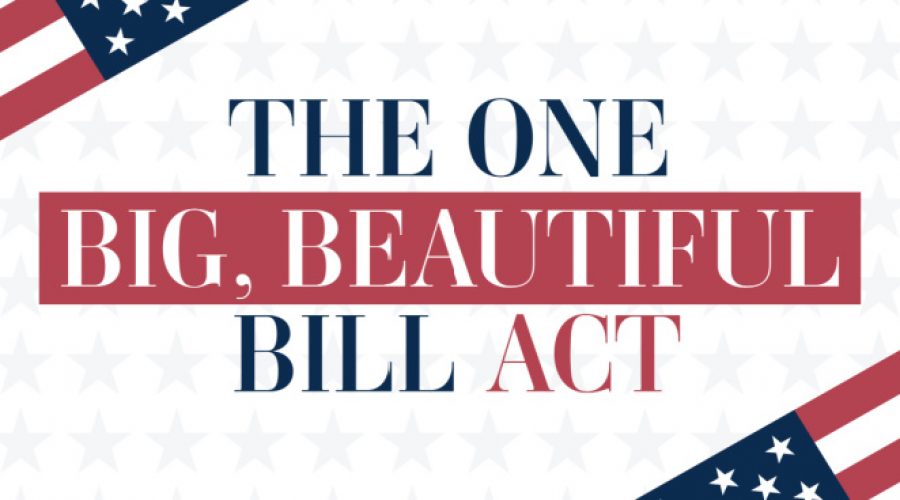On July 4th, the One Big Beautiful Bill (OBBB) was signed into law. This new bill brings sweeping changes to the U.S. tax code, for individuals and for business. OBBB extends many provisions of the 2017 Tax Cuts and Jobs Act (TCJA), as well as introduces new deductions, credits, and adjustments aimed at supporting workers, families, and businesses.
We have summarized the major changes of the OBBB for individuals and for business. We wanted to separate out the 2 so as to make the information more easily digestible and more efficient to look through.
Below is a summary of the major changes brought about by this new bill for individual taxpayers.
Tax Rates and Deductions:
The OBBB makes the current tax bracket rates permanent, while adding additional inflation adjustments to bracket thresholds. The increased standard deduction also becomes permanent, rising in 2025 to $15,750 for single filers and $31,500 for married couples filing jointly, with future inflation adjustments.
The current cap on state and local tax (SALT) deductions rises from $10,000 to $40,000 temporarily (this provision extends through 2029 before reverting back down). This gives some relief to taxpayers in high-tax states. This change also allows for some tax planning opportunities, such as the option to “bunch” itemized deductions for things like property taxes into one tax year; this, in turn, increases itemized deductions and reduces taxable income.
Another big adjustment provided by this bill is regarding the Estate & Gift tax exemption. This exemption was increased significantly back in 2017 with TCJA, but was set to expire and revert back to the previous threshold at the end of 2025. However, the OBBB made this higher exemption amount, which is indexed for inflation, permanent. The 2026 exemption threshold has been set at $15 million ($30 million for couples).
Benefits for Families and Seniors:
Several provisions bolster support for families and older taxpayers:
- Child tax credit: Increased to $2,200 per child, with permanent inflation adjustments and a refundable portion of $1,400.
- Child & dependent care credit: The maximum rate increases from 35% to 50%, with a higher income threshold before it phases down.
- Adoption credit: Up to $5,000 of the adoption credit becomes refundable.
- Senior deduction: Taxpayers aged 65+ receive a temporary additional deduction of $6,000 (for itemizers and non-itemizers). This is in addition to the already higher standard deduction received by those 65+.
New and Enhanced Deductions:
Two new (but temporary) deductions aim to ease the tax burden for workers in certain industries:
- Tips deduction: Up to $25,000 in qualified tips can be deducted between 2025–2028, covering both employees and independent contractors.
- Overtime deduction: Up to $12,500 ($25,000 for joint filers) in qualified overtime pay is deductible over the same period.
For auto buyers, the bill allows taxpayers to deduct up to $10,000 in interest on loans for U.S.-assembled passenger vehicles through 2028.
Changes to Other Key Provisions:
The bill also makes several additional important adjustments:
- Charitable deductions: For tax payers who itemize, charitable deductions will be limited to charitable contributions in excess of 0.5% of the taxpayer’s Adjusted Gross Income (AGI).
- Qualified Business Income (QBI) deduction: Permanently retained at 20%, with expanded income phase-in ranges.
- Mortgage interest: TCJA limits are made permanent.
- Miscellaneous deductions: The Pease limitation (which reduced itemized deductions for high earners) is replaced with a new formula; unreimbursed educator expenses are exempted from the miscellaneous deduction suspension.
- Wagering losses: More tightly capped at 90% of gains from gambling.
New Savings and Education Options:
The OBBB also aims to encourage higher education and greater/earlier retirement savings for Americans. One of the ways they are trying to increase early savings is through a new type investment account called “Trump Accounts”. These accounts are similar to Nondeductible IRAs, but have some special, additional rules. Trump accounts must be created before the beneficiary reaches age 18, they have an annual contribution cap of $5,000 (indexed for inflation), contributions are nondeductible, and contributions to a Trump account in years before the beneficiary reaches age 18 don’t limit contributions to other retirement plans (such as Roth IRAs).
In order to encourage higher education, the bill expands 529 education savings plans to cover more types of schooling and credentialing expenses. It also allows for a $1,700 credit for contributions to scholarship-granting organizations, and a charitable deduction for non-itemizers of up to $2,000, aim to boost charitable giving and support education.
Relief for Special Situations:
- Student loans: Discharged debt from death or disability remains excluded from taxable income.
- ABLE accounts: Higher contribution limits and saver’s credit eligibility are made permanent.
- Casualty losses: Expanded to include some state-declared disasters.
- Dependent care assistance programs: Maximum excludable benefit increases from $5,000 to $7,500.
What This Means for Taxpayers:
Now that this bill is officially in place, there is more clarity and stability in terms of what can be expected for the foreseeable tax future, which allows individuals and businesses to plan with more certainty.
Taxpayers should carefully review these provisions, especially the temporary ones, to take full advantage of the available benefits. Be sure to contact your advisor to help you navigate the nuances of this new legislation and maximize savings for your specific financial situation.
